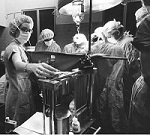Revised May 2025
New (and old) Gas Machines
- Dräger Medical Inc. (Telford, PA)
- Apollo, Perseus, Fabius GS
- GE (Madison WI)
- Aisys, Avance, Aespire, Aestiva, Aestiva MRI
- Other
- Penlon, Mindray A5, Maquet
- Older or obsolete
- Narkomed (6400, GS, Julian, MRI, Mobile, 2C, 4), Kion, Ohmeda (ADU, Modulus SE, Excel 210/110), Anestar
Advanced ventilators are the biggest difference between new and older gas machines. (Review previous section on this site on ventilators now.)
This page is a general survey of gas machines available for purchase, or older machines still in use in North America. For each gas machine model you may find comments, important features, a picture, how it fits in with your current equipment, and limited specifications (like size, number of vaporizers or flowmeters).
Dräger Medical Inc. (Telford, Pennsylvania)
Apollo
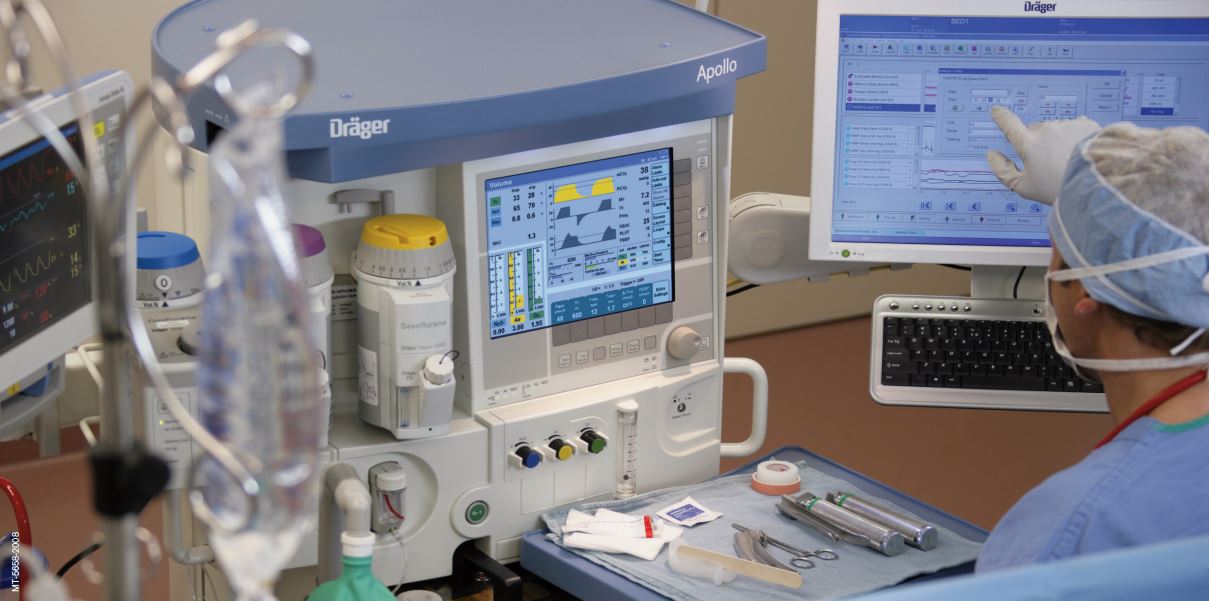 |
Apollo. Click on the thumbnail, or on the underlined text, to see the larger version. |
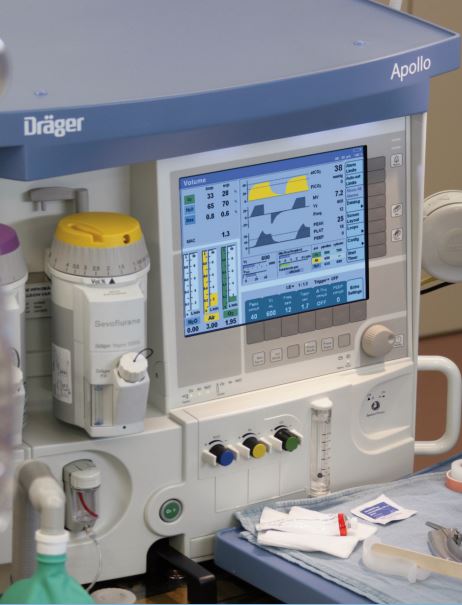 |
Apollo controls. Click on the thumbnail, or on the underlined text, to see the larger version. |
- Monitoring includes:
- Volume, Pressure, inspired Oxygen (VPO), Gas analysis, CO2, Spirometry
- Ventilator: Piston ventilator with tidal volume corrected for leaks, patient and breathing circuit compliance, and fresh gas flow (by fresh gas decoupling). There is no "bag/vent" switch, since changing ventilator mode is controlled electronically. It is accurate to very low tidal volumes in volume control mode (range 20-1400 mL). Use pediatric circle system hoses for low VT, and repeat leak/compliance test when changing circuits. Can view measured respiratory parameters or ventilator settings, but not both simultaneously.
- Vent Modes- VCV, Volume-Autoflow, PCV, PSV, SIMV-Volume, SIMV-Pressure (either synchronized mode may be combined with PSV), Manual/Spontaneous.
- Machine checklist: Electronic self-test with some aspects performed manually.
- Flowmeters: Traditional mechanical needle valves with electronic display, and total fresh gas flow glass flowtube. Electronic capture of fresh gas flows. No minimum oxygen flow. S-ORC (sensitive-oxygen ratio controller) for hypoxic guard.
- Vaporizers: Variable-bypass vaporizers are used, and these may be removed without tools. Vapor 2000, Vapor 19, or Tec 6.
- Breathing circuit: The breathing circuit is lower volume (1.5 L absorbent volume). Pre-packaged or loose carbon dioxide absorbent granules may be used.
- Scavenger: Open scavenger interface.
- Electrical power failure: At least 30 minute battery reserve with fresh gas, vaporizers, integrated monitors, and ventilator operational. Patient monitors will not function, as they are not part of the gas machine. Pneumatic functions remain after battery is exhausted (vaporizers, S-ORC, APL valve, flowmeters, breathing pressure gauge, cylinder and pipeline pressure gauges, total fresh gas flowmeter).
- Other features: Fresh gas decoupling causes manual breathing bag to fluctuate during mechanical ventilator cycle (it fills on mechanical ventilator inspiration), which serves as a further disconnect alarm.
- Web site: Dräger Equipment site/US; Apollo Description, Specifications
- Weight: 165 kg without cylinders and vaporizers.
- Comments/Where this machine fits: Modern, top of the line machine with an excellent ventilator. Can interface with integrated or add-on physiologic monitors.
Perseus A500
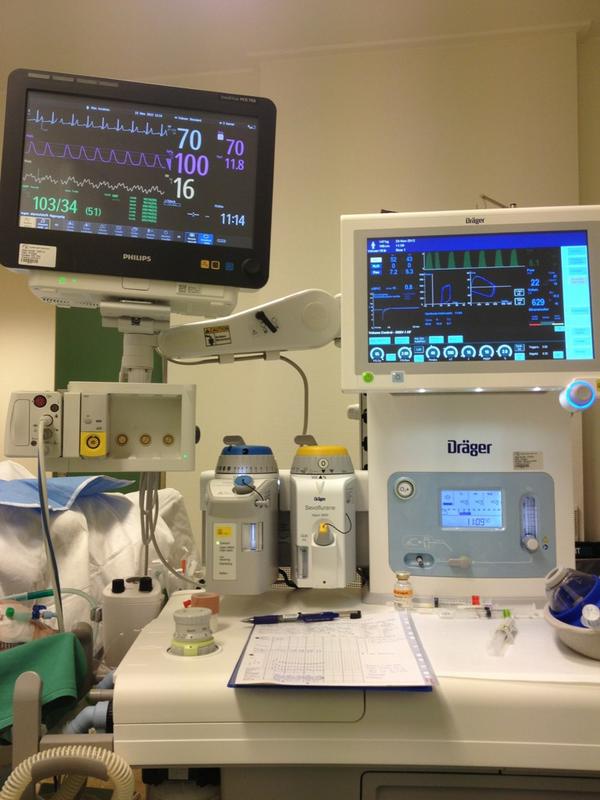 |
Perseus. Click on the thumbnail, or on the underlined text, to see the larger version. |
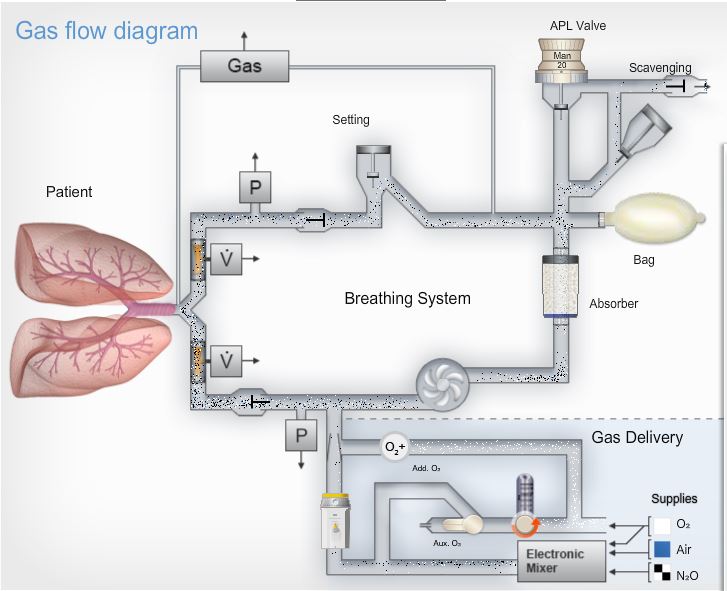 |
Perseus breathing circuit. Click on the thumbnail, or on the underlined text, to see the larger version. |
- Monitoring includes:
- Volume, Pressure, inspired Oxygen (VPO), Gas analysis, CO2, Spirometry
- Ventilator: Turbine ventilator with tidal volume corrected for leaks, patient and breathing circuit compliance, and fresh gas flow (by fresh gas compensation). Unique in that it is the first turbine ventilator in anesthesia in US; also, first to offer APRV. There is no "bag/vent" switch, since changing ventilator mode is controlled electronically. It is accurate to very low tidal volumes (range 20-1400 mL). Use pediatric circle system hoses for low VT, and repeat leak/compliance test when changing circuits.
- Vent Modes- VC-CMV (+ Autoflow, SIMV, PEEP, PSV). PC-CMV (+ SIMV, PSV, PEEP), PC-BiPAP, APRV, CPAP. Manual/Spontaneous.
- Machine checklist: Electronic self-test with some aspects performed manually.
- Flowmeters: Traditional mechanical needle valves with electronic display, and total fresh gas flow glass flowtube; electronic gas mixer version also available. Electronic capture of fresh gas flows. No minimum oxygen flow. S-ORC (sensitive-oxygen ratio controller) for hypoxic guard.
- Vaporizers: Variable-bypass vaporizers are used, and these may be removed without tools. Vapor 3000.
- Breathing circuit: The breathing circuit is lower volume (1.5 L absorbent volume; 2.1 L total volume). Pre-packaged or loose carbon dioxide absorbent granules may be used.
- Scavenger: Open scavenger interface.
- Electrical power failure: At least 30 minute battery reserve with fresh gas, vaporizers, integrated monitors, and ventilator operational. Patient monitors may not function. Pneumatic functions remain after battery is exhausted (vaporizers, S-ORC, APL valve, flowmeters, cylinder and pipeline pressure gauges, total fresh gas flowmeter).
- Other features: Manual breathing bag fluctuates during mechanical ventilator cycle, which serves as a further disconnect alarm (bag empties during inspiration [opposite to Apollo]).
- Web site: Perseus Description, Specifications.
- Weight: 150 kg without cylinders and vaporizers.
- Comments/Where this machine fits: Modern, top of the line machine with a novel and capable ventilator.
Fabius GS
 |
Fabius GS. Click on the thumbnail, or on the underlined text, to see the larger version (36 KB). |
 |
Fabius GS flowmeters. Click on the thumbnail, or on the underlined text, to see the larger version (29 KB).
|
- Monitoring includes:
- Volume, Pressure, inspired Oxygen (VPO)
- Galvanic cell oxygen analysis. New sensors need a 15 minute warmup/waiting period before calibration.
- Thermal anemometry ("hot wire") flow sensor in the breathing circuit (unique to this machine, Apollo, Perseus, and a few others). May be sensitive to humidity or radio-frequency interference (from electrosurgery units). Displays tidal (VT) and minute (VE) volume, respiratory rate, respiratory pressure waveform.
- Ventilator: Piston ventilator with tidal volume corrected for leaks, patient and breathing circuit compliance, and fresh gas flow (by fresh gas decoupling). Vertical piston visible during cycling in window to left of flowmeters. "Fresh gas low" error warns of piston entraining room air (negative pressure threshold -2 to -5 cm of water). There is no "bag/vent" switch, since changing ventilator mode is controlled electronically. It is accurate to very low tidal volumes (range 20-1400 mL). Use pediatric circle system hoses for low VT, and repeat leak/compliance test when changing circuits. Can view measured respiratory parameters or ventilator settings, but not both simultaneously.
- Vent Modes- VCV, PCV, PSV, SIMV-Volume with PSV, Manual/Spontaneous.
- Machine checklist: Basically a manual FDA-style checklist with a few electronic self-tests (system, leaks, flow sensor, oxygen sensor).
- Flowmeters: Vertically arranged needle valves, digital numeric flow display, total fresh gas flow glass flowtubes, and graphic display of each flow on a separate screen. Electronic capture of fresh gas flows. No minimum oxygen flow. S-ORC (sensitive-oxygen ratio controller) for hypoxic guard.
- Vaporizers: Variable-bypass vaporizers are used, and these may be removed without tools. Vapor 2000, Vapor 19, or Tec 6.
- Breathing circuit: The absorber head is not warmed. The breathing circuit is lower volume (2.8 L of which 1.5 L is absorbent volume). Pre-packaged or loose carbon dioxide absorbent granules may be used. Manufacturer recommends changing if the machine has been idle for 48 hours, or each week on Monday. Cannot be used with non-rebreathing circuits.
- Scavenger: Open scavenger interface.
- Electrical power failure: 45 minute battery reserve with fresh gas, vaporizers, integrated monitors, and ventilator operational. Patient monitors will not function, as they are not part of the gas machine. Pneumatic functions remain after battery is exhausted (vaporizers, S-ORC, APL valve, flowmeters, breathing pressure gauge, cylinder and pipeline pressure gauges, total fresh gas flowmeter).
- Other features: Desflurane compensation must be entered by the operator when this agent is used, to prevent inaccuracy in respiratory flow measurement. Fresh gas decoupling causes manual breathing bag to fluctuate during mechanical ventilator cycle, which serves as a further disconnect alarm.
- Web site: only the Fabius MRI version is currently listed at Dräger web; Fabius GS Description, Specifications.
- Weight: 101 kg without cylinders and vaporizers.
- Comments/Where this machine fits: Modern, top of the line machine with an excellent ventilator. An economical choice particularly if one wishes to retain one's current patient monitoring system. Must supply own patient monitors, and gas analysis. Variations include models for MRI, Tiro (for constrained spaces), Tiro M (military field machine for forward areas).
GE Healthcare (Madison, Wisconsin)
Aisys
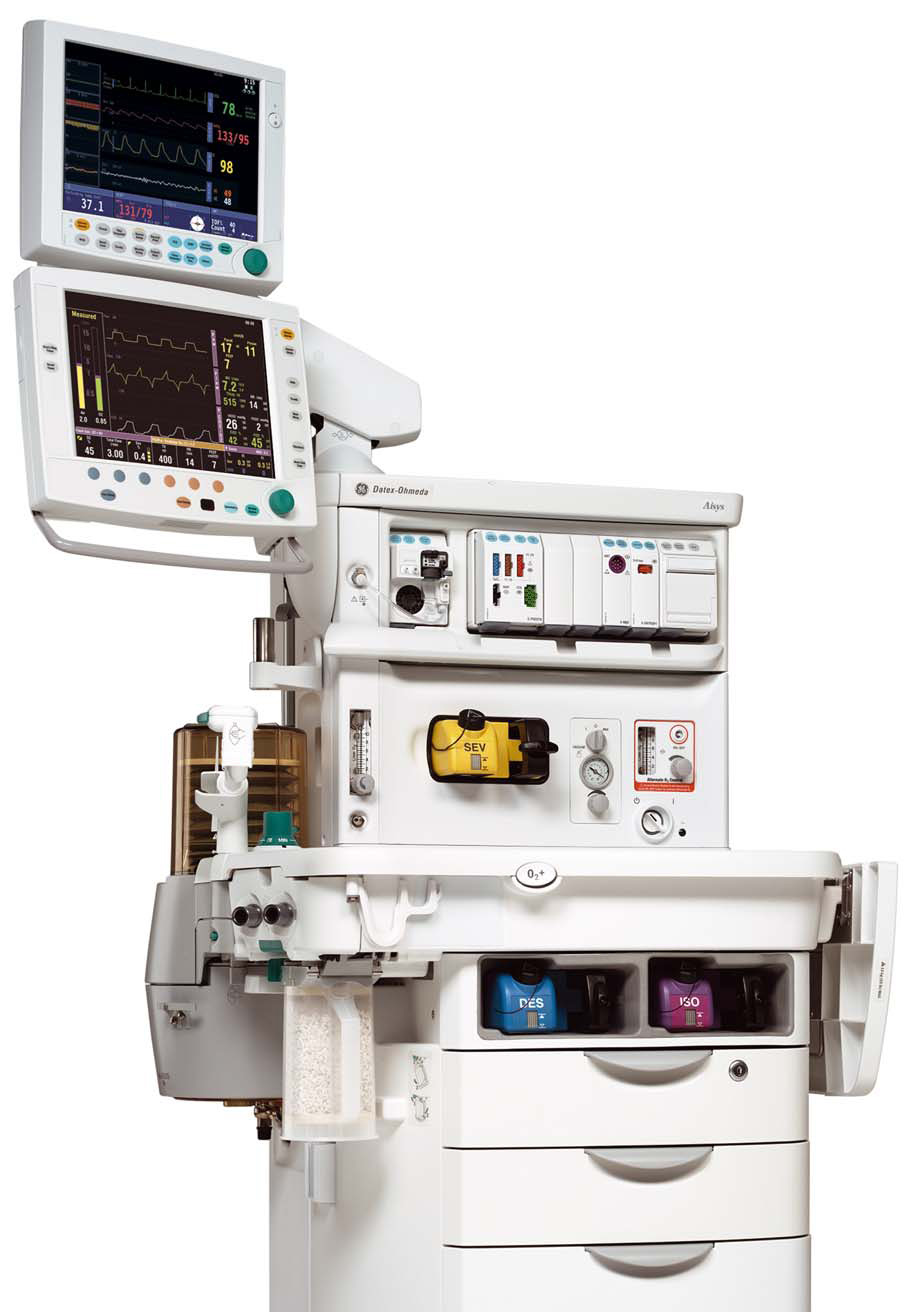 |
Aisys. Click on the thumbnail, or on the underlined text, to see the larger version (202 KB).
|
- Monitoring included:
- Volume, Pressure, paramagnetic Oxygen (VPO), spirometry, agent analysis, capnography . Optional integrated physiologic monitoring
- Ventilator: New model GE 7900 with ascending ("standing") bellows, dual circuit, pneumatically-driven ventilator with tidal volume corrected for leaks, compliance, and fresh gas flow. Variable orifice flow sensors compensate for compliance losses and leaks from their location near the breathing circuit unidirectional valves. Accurate to very low tidal volumes in volume control mode (20-1500 mL). The "bag/vent" switch activates the mechanical ventilator in one step.
- Vent Modes Manual/Spontaneous, Volume Control, Pressure Control, PCV with Volume guarantee, PSVPro (Pressure Support with Apnea backup), Synchronized Intermittent Mandatory Ventilation (SIMV with Volume or Pressure controlled), electronic PEEP
- Machine checklist: Automated checklist with some manual steps.
- Flowmeters: electronic control and capture of FGF. No minimum oxygen flow.
- Vaporizers: Electronic control of vaporization, uses Aladin cassettes (like Avance).
- Breathing circuit: The advanced breathing circuit has 2.7 L volume in mechanical ventilator mode, 1.2 L in bag mode (800 gm absorbent). Loose fill granules or prepackaged absorbent.
- Scavenger: Closed, open, or passive scavenger interface available.
- Electrical power failure: 30 minute battery reserve. Safety oxygen flow control allows oxygen flow in the absence of electrical power.
- Other features:
- Web site: Aisys Features, Description, Specifications.
- Weight: 168 kg
- Comments/Where this machine fits: Advanced ventilation modes and monitoring, low volume breathing circuit. EtControl- Electronic control of FGF and vaporization to assure targeted end-tidal oxygen and anesthetic agents are achieved and maintained at selected minimum FGF.
Avance
 |
Avance. Click on the thumbnail, or on the underlined text, to see the larger version (414 KB).
|
The Avance uses the same new GE 7900 ventilator and breathing system as the Aisys. The difference in the machines is that the Avance uses conventional pneumatic/mechanical vaporizers. Web site: Not currently on GE Healthcare web. Copy of Avance CS2 Description, Specifications is linked.
Aespire
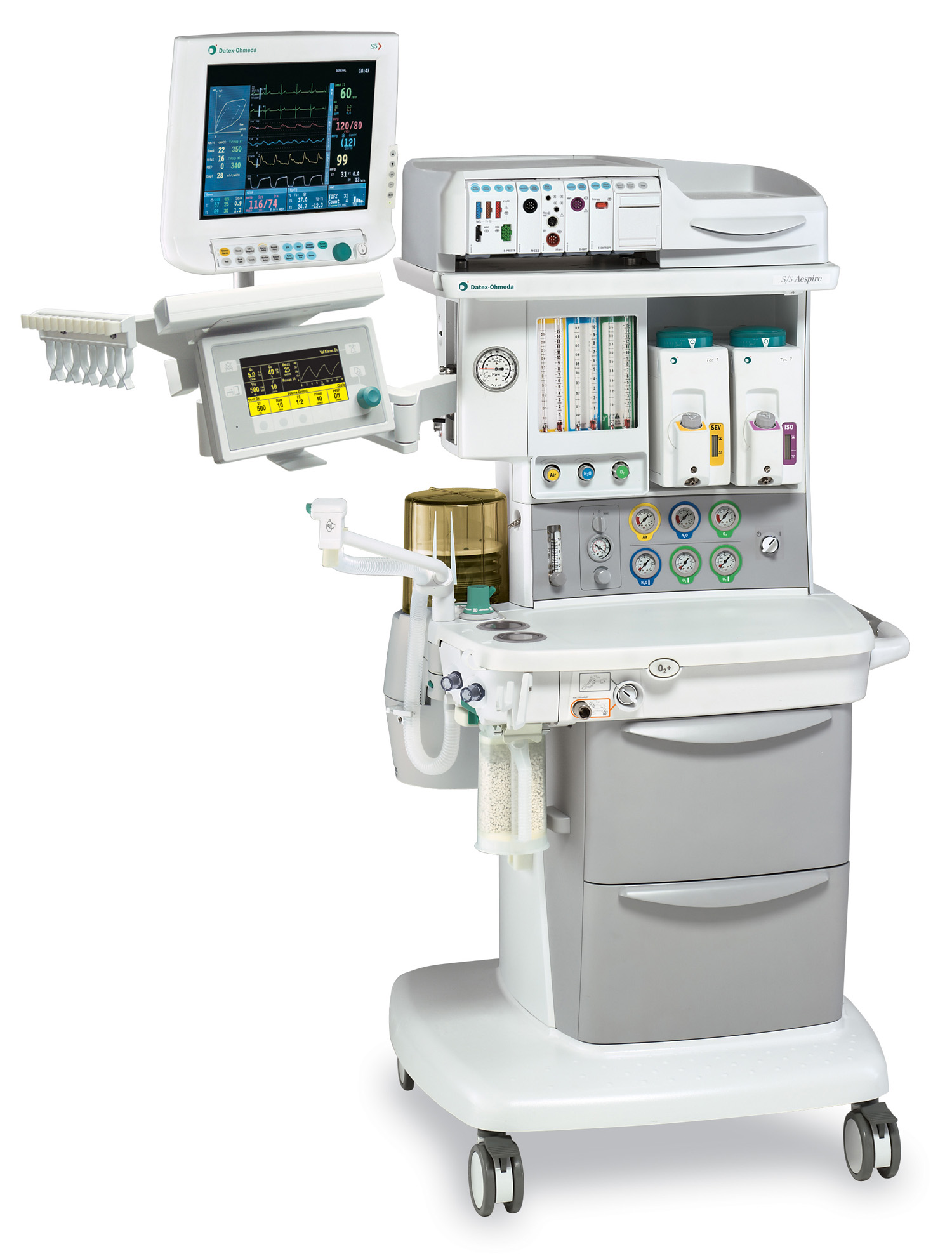 |
Aespire. Click on the thumbnail, or on the underlined text, to see the larger version (414 KB).
|
 |
7100 controls . Click on the thumbnail, or on the underlined text, to see the larger version (43 KB).
|
Aespire (and Aestiva) share the current GE 7100 ventilator. Like Avance, Aespire uses traditional vaporizers. Aespire shares the Advanced Breathing System used by Aisys and Avance. The 7100 ventilator features VCV, PCV, and electronic PEEP. VT range is 45-1500 mL. Maximum inspired pressure is 50 cm water. Web site: Not currently on GE web. A copy of Aespire Description, Specifications is linked.
Aestiva/5, and Aestiva/5 MRI
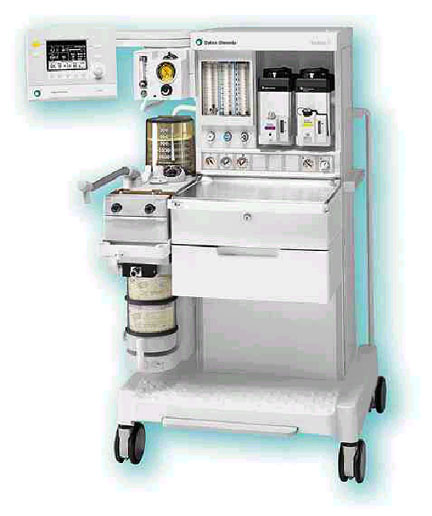 |
Aestiva. Click on the thumbnail, or on the underlined text, to see the larger version (44 KB). |
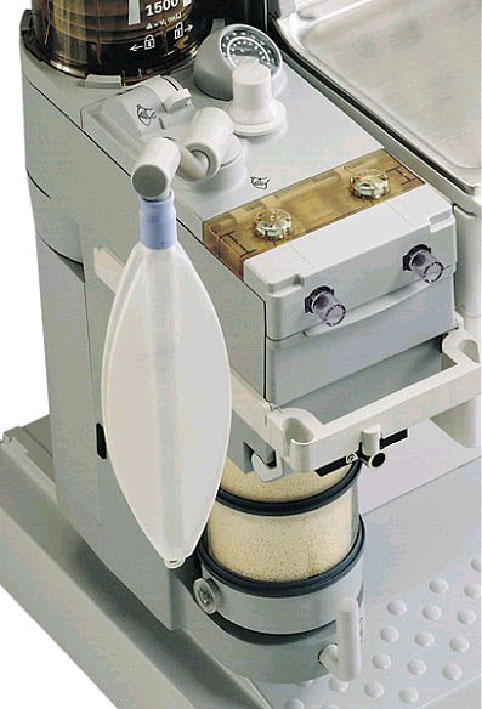 |
Aestiva absorber head. Click on the thumbnail, or on the underlined text, to see the larger version (78 KB).
|
- Monitoring includes:
- Volume, Pressure, inspired Oxygen (VPO)
- Ventilator: Older 7900 ascending ("standing") bellows, dual circuit, pneumatically-driven ventilator with tidal volume corrected for leaks, compliance, and fresh gas flow. Variable orifice flow sensors that accomplish this only compensate for compliance losses proximal to their location near the breathing circuit unidirectional valves, so compliance losses in the breathing circuit are not compensated. Accurate to very low tidal volumes in VCV mode (20-1500 mL). The "bag/vent" switch activates the mechanical ventilator in one step.
- Vent Modes VCV, PCV, SIMV (optional), pressure support ventilation (PSV), Manual/Spontaneous.
- Machine checklist: Manual checklist. Users must review operator's manual to check the machine correctly.
- Flowmeters: Traditional mechanical needle valves and glass flowtubes. No electronic capture of fresh gas flows. Minimum oxygen flow 50 mL/min.
- Vaporizers: Variable-bypass vaporizers are used (Tec 4, 5, 6, 7), and these may be removed without tools.
- Breathing circuit: The breathing circuit is higher volume (5.5 L, including dual canisters of 1.35 kg absorbent each). Loose fill granules or prepackaged absorbent. The machine is compatible with non-rebreathing circuits.
- Scavenger: Closed scavenger interface.
- Electrical power failure: 30 minute battery reserve with fresh gas, vaporizers, and ventilator operational.
- Other features: Also available in an MRI-compatible version.
- Weight: 136-154 kg
- Comments/Where this machine fits: Traditional size and design gas machine, updated configuration of absorber head (easier disassembly and cleaning). Excellent ventilator capable of PCV- first gas machine to feature Pressure support mode. Variable orifice flow sensors have shown some sensitivity to moisture in the breathing circuit in the past. Must purchase own gas analysis and patient physiologic monitors.
Other manufacturers
Penlon
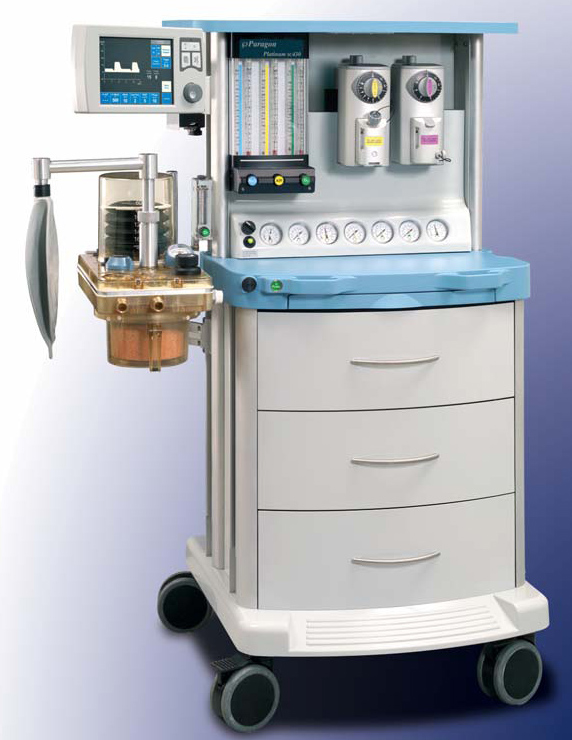 |
Penlon SP2. Click on the thumbnail, or on the underlined text, to see the larger version (157 KB).
|
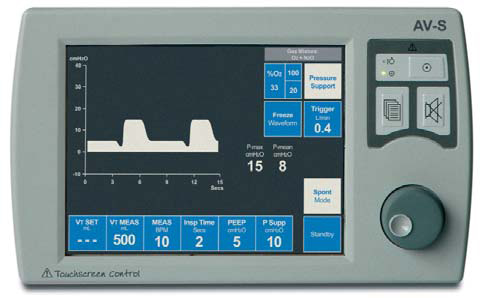 |
AV-S ventilator. Click on the thumbnail, or on the underlined text, to see the larger version (48 KB).
|
The Penlon SP2 features traditional glass FGF flowmeters and conventional vaporizers, combined with an advanced ventilator. Absorbent capacity is 1.3 kg of loose or pre-packed absorbent. The breathing circuit is latex free.
The DRE Integra SL3 also appears to be a Penlon SP2 or very similar.
The AV-S ventilator offers integrated FGF compensation, VPO (volume, pressure, oxygen) and spirometry monitoring, and automated compliance and leak testing. VCV (20-1600 mL/breath), PCV (to 70 cm H2O), and PSV modes are available with integrated electronic PEEP. Insp/Exp ratio is selectable from 1:0.3 to 1:8. Pmax 80 cm H2O. The standing bellows may be driven by oxygen or air.
Mindray
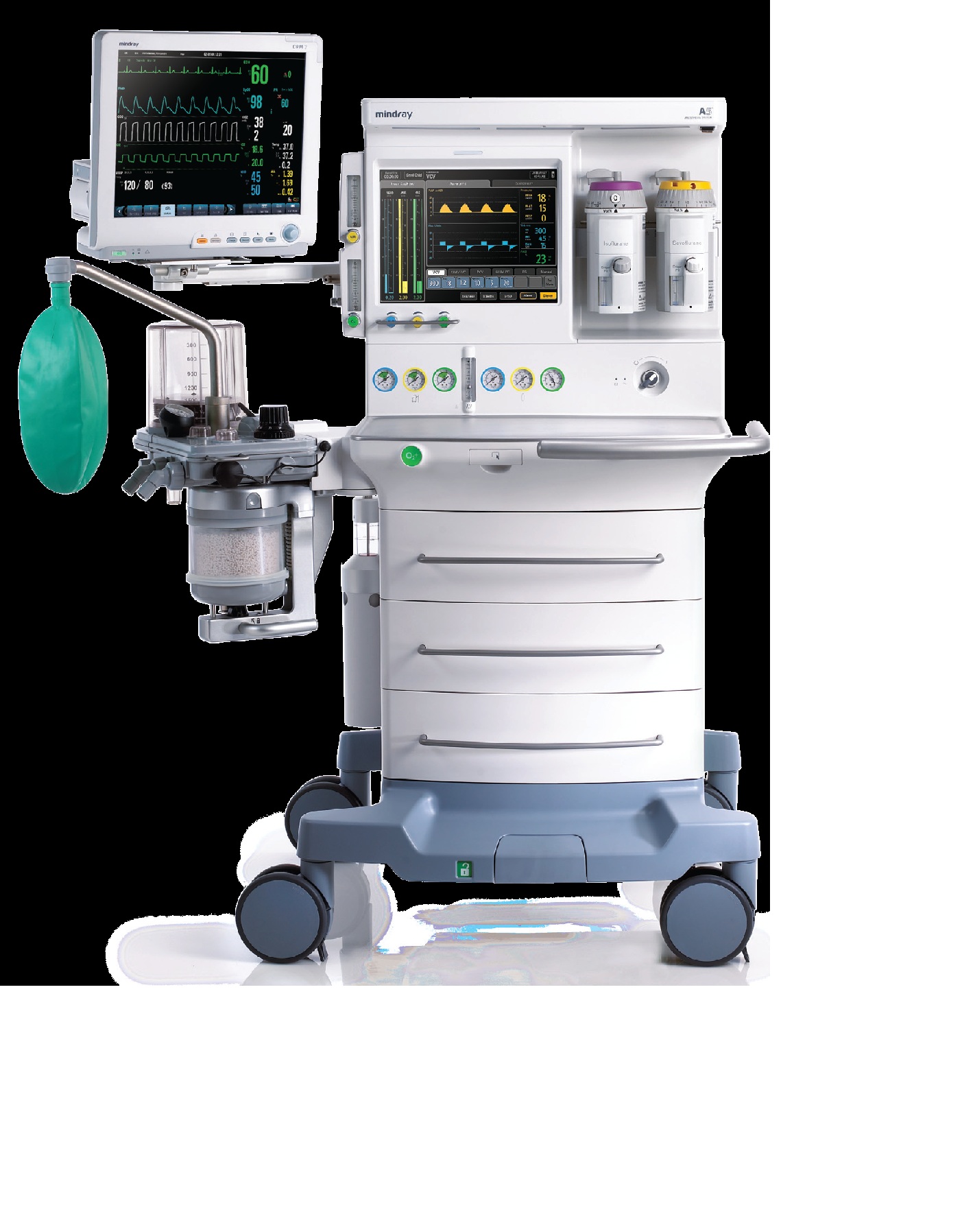 |
Mindray A5. Click on the thumbnail, or on the underlined text, to see the larger version (340 KB). |
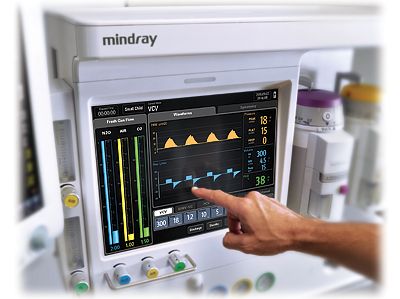 |
Mindray A5 controls. Click on the thumbnail, or on the underlined text, to see the larger version (24 KB).
|
Mindray A4, A5, A7, A8, A9. Range of workstations with traditional flowmeters, up to electronic gas mixer flow control. All with traditional pneumatic variable-bypass vaporizers. Mindray A7 features and specifications. Mindray operators manuals.
Maquet Flow-e
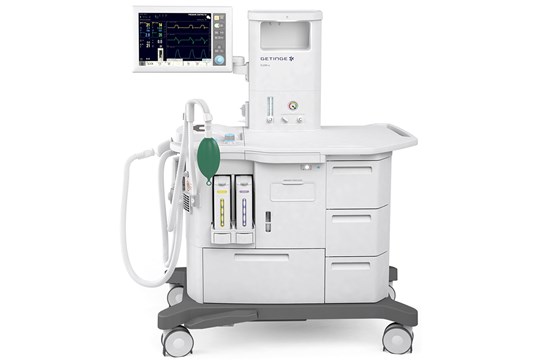 |
Maquet Flow-e. Click on the thumbnail, or on the underlined text, to see the larger version.
|
Maquet Flow-e An anesthesia workstation built around the SERVO ventilator. Many innovative features including: active hypoxic O2 Guard, volume reflector in the breathing circuit, electronic injector vaporizers, and volume reflector indicator to optimize degree of rebreathing.
Older or obsolete machines
Narkomed 6400 and 6000
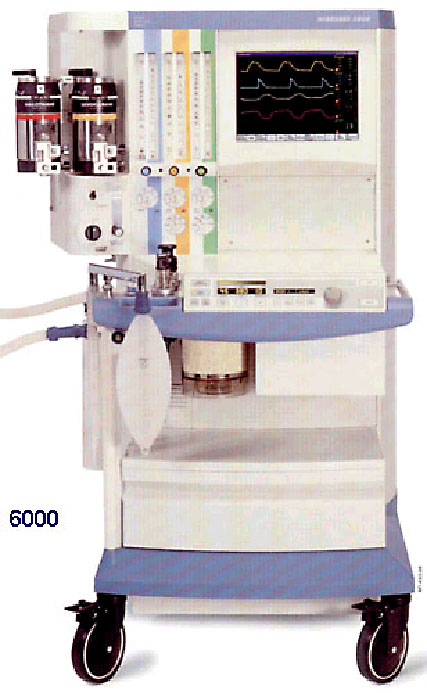 |
NM 6000. Click on the thumbnail, or on the underlined text, to see the larger version (67 KB).
|
 |
NM 6000-Flowmeters, Vapor 2000. Click on the thumbnail, or on the underlined text, to see the larger version (100 KB).
|
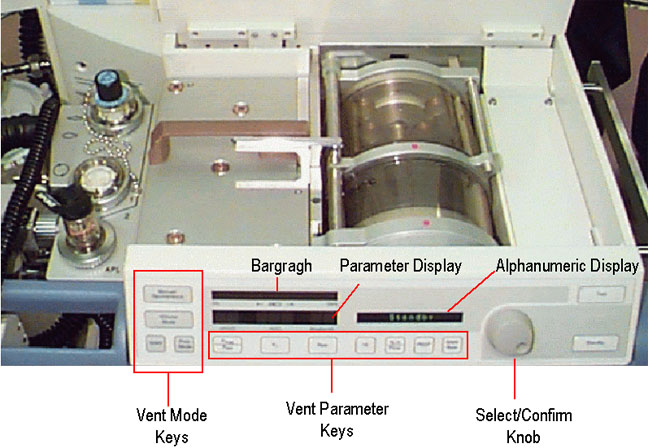 |
NM 6000-Vent controls. Click on the thumbnail, or on the underlined text, to see the larger version (78 KB). |
- Monitoring includes:
- Volume, Pressure, inspired Oxygen (VPO)
- Galvanic cell oxygen analysis. Two sensors whose values are compared. New sensors need a 15 minute warmup/waiting period before calibration.
- Gas monitoring (infrared agent and CO2)
- Ultrasonic flow sensor in the breathing circuit (unique to this machine). Pressure transducers measure the flight time of two ultrasonic waves passing upstream and downstream in the airway flow path, yielding velocity and flow of gas in the breathing circuit. Displays tidal (VT) and minute (VE) volume, respiratory rate, respiratory volume waveform.
- An integrated patient monitoring module is available as an option, so that all parameters are displayed on a single touch screen. This includes: ECG (up to seven leads), ST Segment Analysis, 4 invasive blood pressures, non-invasive blood pressure, pulse oximetry, temperature (2 sites), thermodilution cardiac output, and output for communication with defibrillators and intra-aortic balloon pumps.
- Ventilator: Piston ventilator (Divan) with tidal volume corrected for leaks, patient and breathing circuit compliance, and fresh gas flow (by fresh gas decoupling). "Fresh gas low" error warns of piston entraining room air. There is no "bag/vent" switch, since changing ventilator mode is controlled electronically. It is accurate to very low tidal volumes (range 10-1400 mL). Use pediatric circle system hoses for VT less than 200 mL (repeat vent self-test when changing circuits).
- Vent Modes volume control (VCV), pressure control (PCV), synchronized intermittent mandatory ventilation (SIMV), Manual/Spontaneous.
- Machine checklist: From cold startup, 1 minute power-on self test, then 5 minute ventilator self-test. Can bypass ventilator test 10 days or ten times only, after which ventilator is unavailable until its self-test is performed. Because circuit compliance is measured and tidal volume is adjusted accordingly, the manufacturer discourages expandable circuit hoses. Periodic leak test is performed during use. The machine checkout basically follows FDA guidelines but there are some non-trivial differences. For example, the manufacturer recommends breathing through each circuit limb to test check valves, and disconnecting the oxygen wall hose to check oxygen pipeline pressure-failure device. Users must review operator's manual to check the machine correctly.
- Flowmeters: traditional mechanical/pneumatic (needle valves and glass flowtubes), but electronic capture of fresh gas flows has recently been added. Minimum oxygen flow 150 mL/min. Pneumatic ORC (oxygen ratio controller) for hypoxic guard.
- Vaporizers: Variable-bypass vaporizers are used, and these may be removed without tools. Vapor 2000.
- Breathing circuit: The absorber head is warmed, and the breathing circuit is lower volume (1.5 L absorbent volume). Only loose carbon dioxide absorbent granules may be used. The machine is not compatible with non-rebreathing circuits.
- Scavenger: Open scavenger interface, or passive.
- Electrical power failure: 30 minute battery reserve with fresh gas, vaporizers, monitors, and ventilator operational.
- Other features: Low flow wizard. Ventilator override switch assures that if ventilator fails manual/spontaneous breathing can be re-established. Fresh gas decoupling causes manual breathing bag to fluctuate during mechanical ventilator cycle, which serves as a further disconnect alarm.
- Web site: (none)
- Weight: 225 kg
- Comments/Where this machine fits:Recent gas machine with a modern ventilator. May choose integrated patient monitoring from Dräger, or use any other vendor's. No longer actively featured on the web site. Superseded by Apollo, Perseus.
ADU
 |
ADU. Click on the thumbnail, or on the underlined text, to see the larger version (67 KB). |
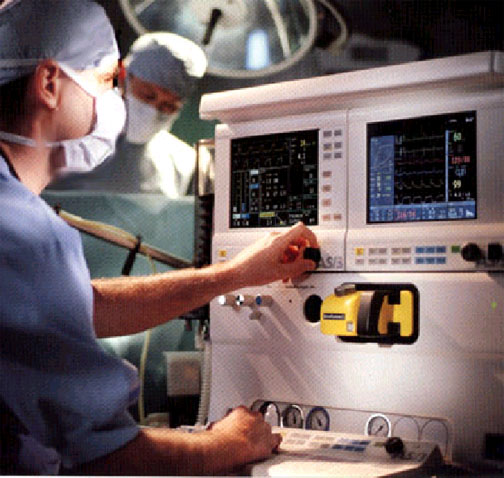 |
ADU screens. Click on the thumbnail, or on the underlined text, to see the larger version (69 KB).
|
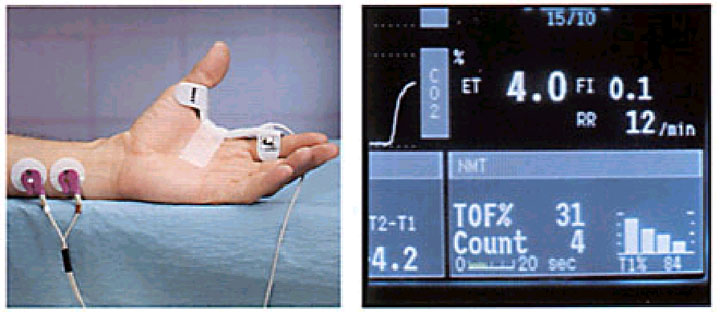 |
NM Block monitoring. Click on the thumbnail, or on the underlined text, to see the larger version (56 KB).
|
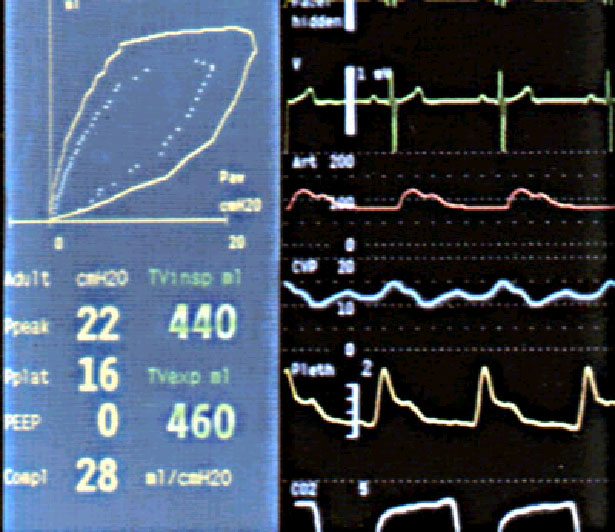 |
ADU spirometry. Click on the thumbnail, or on the underlined text, to see the larger version (94 KB). |
- Monitoring includes:
- Volume, Pressure, inspired Oxygen (VPO)
- Paramagnetic oxygen analysis (much longer sensor life).
- Gas monitoring (agent and carbon dioxide)
- Physiologic monitoring is integrated (EKG, NIBP, Pulse oximetry, Invasive pressures, Cardiac output, Neuromuscular block [optional])
- Spirometry (flow-volume and pressure-volume respiratory loops)
- Ventilator: Ascending ("standing") bellows, dual circuit, pneumatically-driven ventilator with tidal volume corrected for leaks, compliance, and fresh gas flow (by D-Lite sensor at Y-piece). Accurate to very low tidal volumes (20-1400 mL). The "bag/vent" switch activates the mechanical ventilator in one step.
- Vent Modes VCV, PCV, PSV, SIMV-Volume, Manual/Spontaneous.
- Machine checklist: An almost-completely automated checklist. Since the D-Lite sensor is removed from the breathing circuit during checkout, one must perform a high-pressure check of the breathing circuit after reassembly. Users must review operator's manual to check this (or any) gas machine correctly.
- Flowmeters: Traditional mechanical needle valves, no glass flowtubes. Flow is displayed a a bar graph on computer display screen. Backup common gas outlet flowmeter recommended (but optional). Electronic capture of fresh gas flows. No minimum oxygen flow. No valve stops (users can damage needle valves if they are closed too tightly).
- Vaporizers: Variable-bypass vaporizers are used, and these may be removed without tools. Aladin vaporizer cassettes are tippable, since they do not contain the electronic controls (these are within the gas machine). Desflurane cassette does not need supplied heat. Vaporizers are not interchangeable with any other model.
- Breathing circuit: The breathing circuit is lower volume (only 750 mL absorbent volume). Only the manufacturer's carbon dioxide absorbent canisters may be used, which are single-use, or refillable with loose granules. The machine is technically compatible with non-rebreathing circuits, but the need for them is questionable since the ventilator can handle patients who weigh as little as 3 kg.
- Scavenger: Open scavenger interface. Scavenger suction adequacy indicated on optional glass flowmeter.
- Electrical power failure: 30 minute battery reserve with fresh gas, vaporizers, and ventilator operational. Patient monitoring (right screen) is lost unless main electrical power (or generator backup) is available- like most gas machines.
- Other features: Certain disposables are only available from the manufacturer (spirometry tubing, D-Lite sensor, absorbent granule canisters).
- Web site: (None)
- Weight: 110 to 130 kg
- Comments/Where this machine fits: No longer marketed. A European design with a modern ventilator. All monitoring is integrated. Because the physiologic monitoring is built-in, previously-used monitors cannot be "set on top" and used. Superseded by Aisys, Apollo, and others.
Anestar-S
 |
. Click on the thumbnail, or on the underlined text, to see the larger version (367 KB).
|
The Anestar ventilator is a hanging bellows, gas-driven, electronically controlled ventilator. It offers VCV, PCV, and PSV modes. VT is 10-9999 mL. Insp/Exp ratio is 3:1 to 1:5.
The breathing circuit is warmed and VT compensation is achieved through fresh-gas decoupling. Flow sensors are hot-wire anemometers. The internal volume of the breathing system is 2.5 L (of which 1.4 L is absorbent).
Narkomed GS
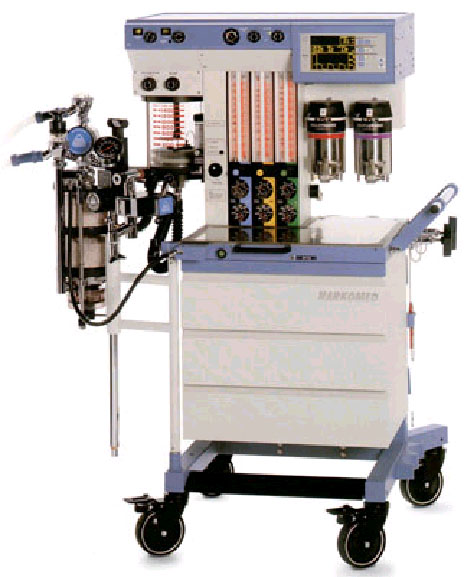 |
Narkomed GS. Click on the thumbnail, or on the underlined text, to see the larger version (59 KB). |
 |
Narkomed GS. Click on the thumbnail, or on the underlined text, to see the larger version (56 KB). |
- Monitoring includes:
- Volume, Pressure, galvanic cell Oxygen (VPO). Electronic Wright respirometer style flow sensor
- Ventilator: Ascending bellows pneumatic double-circuit AV2+ style ventilator without tidal volume compensation. Modes volume control (VCV), Manual/Spontaneous. Mechanical "bag/vent" switch.
- Machine checklist: Manual FDA-style checklist.
- Flowmeters: Traditional needle valve with glass flowtube display.
- Vaporizers: Variable-bypass vaporizers are used. Vapor 19 or Tec 6.
- Breathing circuit: Traditional absorber head. The breathing circuit is higher volume (dual absorbent canisters). May use loose granules or prefilled canisters. May be used with non-rebreathing circuits.
- Scavenger: Open, closed, or passive scavenger interface.
- Electrical power failure: Most functions except patient monitoring are preserved during power failure, as this is a basic pneumatic-mechanical machine. The VPO display will be lost after battery exhaustion.
- Other features:
- Web site: none
- Weight: 170 kg
- Comments/Where this machine fits: This gas machine is intuitive, and economical. Little new technology to learn. Must supply own patient monitors, and gas analysis.
Julian
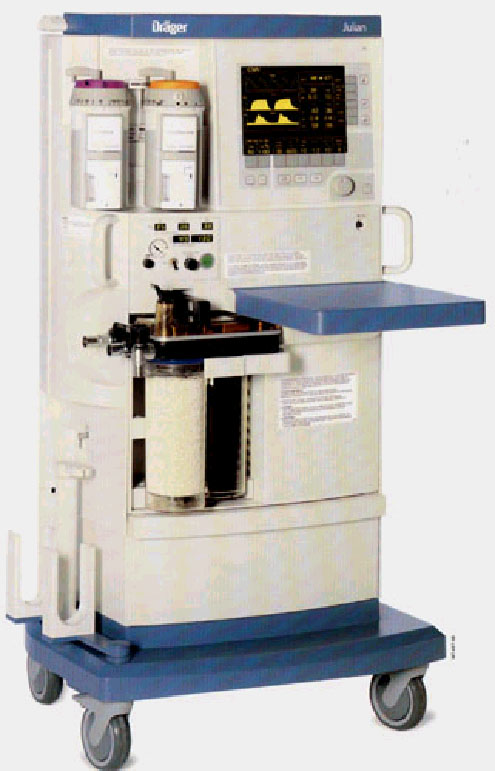 |
Julian. Click on the thumbnail, or on the underlined text, to see the larger version (72 KB). |
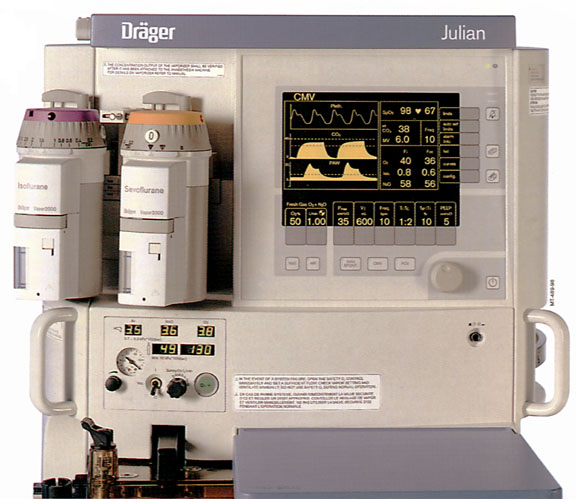 |
Julian close-up. Click on the thumbnail, or on the underlined text, to see the larger version (69 KB). |
 |
Julian flowmeters. Click on the thumbnail, or on the underlined text, to see the larger version (92 KB). |
- Monitoring includes:
- Volume, Pressure, inspired Oxygen (VPO)
- Galvanic cell oxygen analysis.
- Thermal anemometry ("hot wire") flow sensor in the breathing circuit (unique to this machine and the Fabius GS, Apollo, Perseus). May be sensitive to radio-frequency interference (from electrosurgery units). Displays tidal (VT) and minute (VE) volume, respiratory rate, respiratory pressure waveform.
- Infrared gas analysis and capnography.
- Pulse oximetry may be integrated as an option.
- Ventilator: Descending ("hanging") bellows, pneumatically driven dual circuit ventilator with tidal volume compensation for leaks, breathing circuit compliance, and fresh gas flow. Modes volume control (VCV), pressure control (PCV), Manual/Spontaneous. There is no "bag/vent" switch, since changing ventilator mode is controlled electronically. It is accurate to very low tidal volumes (range 50-1400 mL). Use pediatric circle system hoses for VT less than 200 mL, and repeat leak/compliance test when changing circuits.
- Machine checklist: Basically a manual FDA-style checklist with a few electronic self-tests (system, leaks/compliance, oxygen sensor).
- Flowmeters: One of the more unique features of this machine. Total fresh gas flow, carrier gas (nitrous oxide or air), and desired inspired oxygen concentration are set. Entirely electronically controlled; no needle valves or glass flowtubes. Digital numeric flow display, and optional graphic display of each flow on a separate screen. Electronic capture of fresh gas flows. No minimum oxygen flow, electronic hypoxic guard system. "Safety O2" flowmeter as mechanical backup.
- Vaporizers: Variable-bypass vaporizers are used, and these may be removed without tools. Vapor 2000, or Vapor 19.
- Breathing circuit: The absorber head is warmed. The breathing circuit is higher volume (4.5 L without hoses of which 1.5 L is absorbent volume). Only loose carbon dioxide absorbent granules may be used. Cannot be used with non-rebreathing circuits.
- Scavenger: Open scavenger interface.
- Electrical power failure: 30 minute battery reserve with fresh gas, vaporizers, integrated monitors, and ventilator operational. Patient monitors will not function, as they are not part of the gas machine.
- Other features: Breathing system designed to be compact, easily disassembled for cleaning.
- Web site: none
- Weight: 90 kg without cylinders and vaporizers.
- Comments/Where this machine fits: Modern, compact machine with significant design features that diverge from what most US-trained anesthetists are familiar with. Must supply own patient monitors.
Narkomed MRI-2
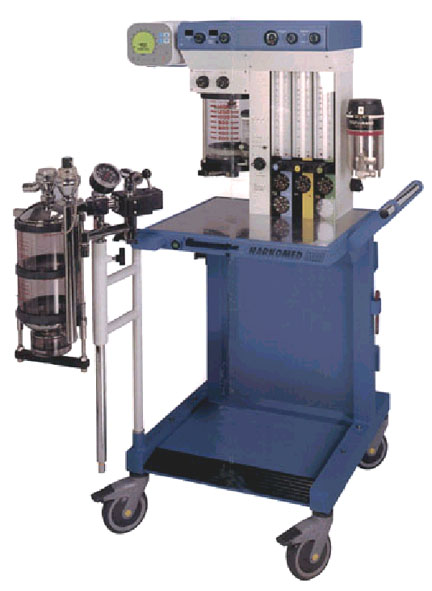 |
Narkomed MRI. Click on the thumbnail, or on the underlined text, to see the larger version (46 KB). |
- Monitoring includes:
- Volume, Pressure, galvanic cell inspired Oxygen (VPO)
- Ventilator: Ascending bellows pneumatic double-circuit AV2+ style ventilator without tidal volume compensation. Modes volume control (VCV), Manual/Spontaneous. Mechanical "bag/vent" switch.
- Machine checklist: Manual FDA-style checklist.
- Flowmeters: Traditional needle valve with glass flowtube display.
- Vaporizers: Variable-bypass vaporizers are used. Vapor 19.
- Breathing circuit: Traditional absorber head. The breathing circuit is higher volume (dual absorbent canisters). May use loose granules or prefilled canisters. May be used with non-rebreathing circuits.
- Scavenger: Open, closed, or passive scavenger interface.
- Electrical power failure: Most functions except patient monitoring are preserved during power failure, as this is a basic pneumatic-mechanical machine.
- Other features: Distributed as "Magnitude-AS" by Invivo Research (who makes MRI-compatible patient monitors).
- Web site: none
- Weight: 230 lbs (104.3 kg)
- Comments/Where this machine fits: Traditional gas machine suited for MRI environment. Must supply own patient monitors, and gas analysis.
Narkomed Mobile and Narkomed M
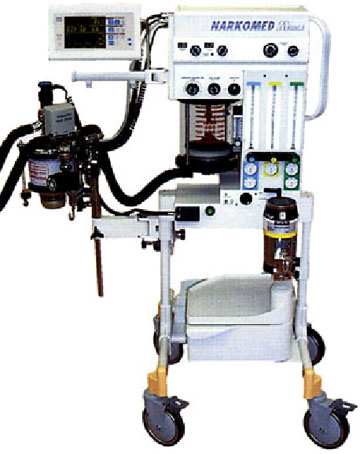 |
Narkomed Mobile. Click on the thumbnail, or on the underlined text, to see the larger version (45 KB).
|
- Monitoring included:
- Volume, Pressure, galvanic cell inspired Oxygen (VPO).
- Ventilator: Ascending bellows pneumatic double-circuit AV2+ style ventilator without tidal volume compensation. Modes volume control (VCV), Manual/Spontaneous. Mechanical "bag/vent" switch.
- Machine checklist: Manual FDA-style checklist.
- Flowmeters: Traditional needle valve with glass flowtube display.
- Vaporizers: Variable-bypass vaporizers are used. Vapor 19.
- Breathing circuit: Traditional absorber head. The breathing circuit is medium volume (single absorbent canister). May use loose granules or prefilled canisters. May be used with non-rebreathing circuits.
- Scavenger: Open or closed scavenger interface.
- Electrical power failure: Most functions except patient monitoring are preserved during power failure, as this is a basic pneumatic-mechanical machine.
- Other features: The M is designed for shipment and transportation by truck, ship, or air.
- Web site: none
- Weight: 75 kg
- Comments/Where this machine fits: Obviously, the strong suit here is the light weight and compact size, making the machine well-suited for anesthesia outside the OR, in the office environment, or whenever a machine must be transported by hand. Must supply own patient monitors, and gas analysis.
Narkomed 2C
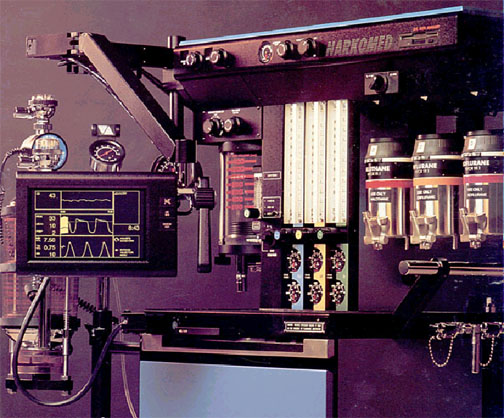 |
Narkomed 2C. Click on the thumbnail, or on the underlined text, to see the larger version (82 KB). |
- Monitoring included: Volume, Pressure, Oxygen (inspired).
- Important features: Ascending bellows ventilator (AV2+). Modes VCV, Manual/Spontaneous. Mechanical/pneumatic flowmeters (needle valves and glass flowtubes) and vaporizers. Traditional size and configuration of absorber head and higher-volume breathing circuit. Loose absorbent granules or canisters. Removable vaporizers. Can be used with non-rebreathing circuits. Open or closed scavenger interface.
- Web site: none
- Weight: (unknown)
- Comments/Where this machine fits: Traditional design and ventilator. Not in production after 2001.
Narkomed 4
 |
Narkomed 4. Click on the thumbnail, or on the underlined text, to see the larger version (86 KB). |
- Monitoring included:
- Volume, Pressure, Oxygen (inspired).
- Gas analysis (Capnography, Agent monitoring).
- Non-invasive BP, Pulse oximetry.
- Important features: Ascending bellows ventilator (AV2+). Modes VCV, Manual/Spontaneous. Mechanical/pneumatic flowmeters (needle valves and glass flowtubes) and vaporizers. Traditional size and configuration of absorber head and higher-volume breathing circuit. Loose absorbent granules or canisters. Removable vaporizers. Can be used with non-rebreathing circuits. Open or closed scavenger interface.
- Web site: none
- Weight: 500 lbs
- Comments/Where this machine fits: Traditional design and ventilator with a higher degree of integrated monitoring. No longer in production since 2001.
Kion
 |
Kion. Click on the thumbnail, or on the underlined text, to see the larger version (64 KB).
|
- Monitoring included: Volume, Pressure, Oxygen (inspired), Capnography and Agent monitoring.
- Important features: Ascending bellows. Modes CMV, PCV, Manual/Spontaneous. Flowmeters- all electronic. Unusual method of setting flows (Inspired oxygen and total fresh gas flow are the two controls). Vaporizers do not work on variable bypass principle (injectors). Absorber head configuration is unique, low volume breathing circuit.
- Web site: none
- Weight: 183 kg
- Comments/Where this machine fits: Modern, top of the line machine from a company that makes excellent ventilators. Design factors are very different than other machines, and only a small number of Kions are installed in US.
Modulus SE
 |
Modulus SE. Click on the thumbnail, or on the underlined text, to see the larger version (86 KB).
|
- Monitoring included: Volume, Pressure, Oxygen (inspired).
- Important features: Ascending bellows ventilator (7800 or older style SmartVent 7900). Modes CMV, PCV (with SmartVent), Manual/Spontaneous. Mechanical/pneumatic flowmeters (needle valves and glass flowtubes) and vaporizers. Traditional size, configuration of absorber head and higher-volume breathing circuit. Loose absorbent granules or canisters. Removable vaporizers. Can be used with non-rebreathing circuits. Open or closed scavenger interface.
- Web site: none
- Weight: 139 kg
- Comments/Where this machine fits: Traditional design and ventilator.
Excel 210, 110
 |
Excel 210. Click on the thumbnail, or on the underlined text, to see the larger version (79 KB). |
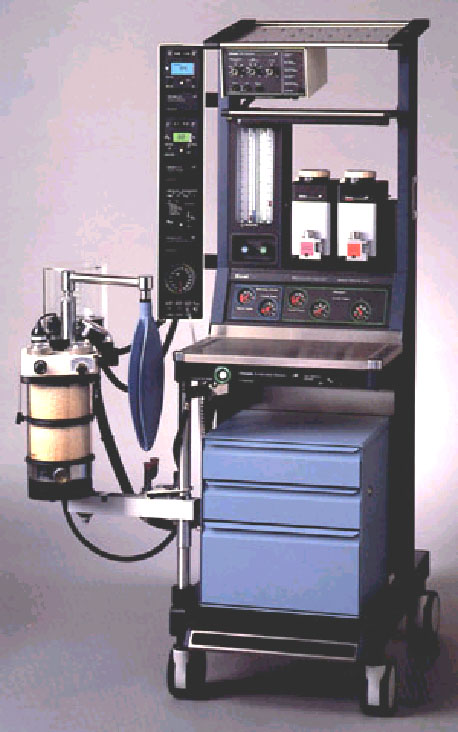 |
Excel 110. Click on the thumbnail, or on the underlined text, to see the larger version (76 KB). |
- Monitoring included: Volume, Pressure, Oxygen (inspired).
- Important features: Ascending bellows ventilator (7000 or 7800). Modes CMV, Manual/Spontaneous. Mechanical/pneumatic flowmeters (needle valves and glass flowtubes) and vaporizers. Traditional size, configuration of absorber head and higher-volume breathing circuit. Loose absorbent granules or canisters. Removable vaporizers. Can be used with non-rebreathing circuits. Open or closed scavenger interface.
- Web site: none
- Weight: 120 kg
- Comments/Where this machine fits: Traditional design and ventilator.
